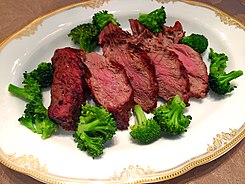 Chateaubriand roast from the front cut of a beef tenderloin | |
| Type | Tenderloin cut of beef |
|---|---|
| Place of origin | France |
| Created by | Chef Montmireil named this dish after Vicomte François-René de Chateaubriand |
| Serving temperature | Hot (45 to 50 °C (113 to 122 °F)) for rare meat served either on a hot plank or on a platter |
| Main ingredients | Tenderloin front cut |
| Variations | Planked Chateaubriand Chateaubriand Bouquetiere Chateaubriand with Duchesse Potatoes Chateaubriand sauce Béarnaise Chateaubriand sauce Colbert Chateaubriand Maitre d'Hôtel Liée |
Chateaubriand (French pronunciation: [ʃatobʁijɑ̃] ; sometimes called chateaubriand steak) is a dish that traditionally consists of a large front cut fillet of tenderloin grilled between two lesser pieces of meat that are discarded after cooking.[1] While the term originally referred to the preparation of the dish, Auguste Escoffier named the specific front cut of the tenderloin the Chateaubriand.
In gastronomy of the 19th century, the steak for Chateaubriand could be cut from the sirloin,[2] and served with a reduced sauce named Chateaubriand sauce or a similar, that was prepared with white wine and shallots moistened with demi-glace, and mixed with butter, tarragon, and lemon juice. It was also traditionally served with mushrooms.[2][3][4]
- ^ Edward Renold; David Foskett; John Fuller (17 August 2012). Chef's Compendium of Professional Recipes. Routledge. pp. 186–187. ISBN 978-1-136-07862-0.
- ^ a b Cite error: The named reference
Goufféwas invoked but never defined (see the help page). - ^ "Gourmet Sleuth - Chateaubriand". Archived from the original on 2012-08-25. Retrieved 2013-09-04.
- ^ Cite error: The named reference
GSwas invoked but never defined (see the help page).